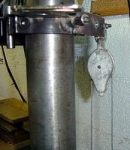Rick,
I think that this is an ingenious idea, but as others have pointed out there are serious issues. The reverse load on the tapers probably being the killer. My first reaction was a worry about the offset load causing jamming at the column but your video shows no sign of that happening. Your lift force is close to the CG.
I faced the same problem with an elderly Craftsman without a rack and pinion lift. I have largely, though not totally, fixed this with a counterweight.
Attachment 29290 Attachment 29291 Attachment 29292 Click images for full size versions.
This system could easily be powered, the top pulley could be replaced by a motor driven drum. The motor could be quite small because the counter weight reduces the lifting force necessary. The counter weight will not be at the CG so there will still be some jamming moments on the column. These moments will vary with load on the table. Of course if you make such an arrangement, with one finger on the "lift/lower" button you have a free hand to assist the lift and better balance those moments.
I can say from my experience that just the static counter weight has made lifting the table so much easier. Prior to adding that I used to avoid moving the table by using blocks under the work piece to get the height necessary. Now I move the table instead.
The high speed sensitive drill that I recently made needed the motor balancing, the table was fixed and so there was no weight variation to cater for and I put effort into balancing the moments.
Attachment 29293
As described in
http://www.homemadetools.net/forum/d...947#post129563 and the movie at


 LinkBack URL
LinkBack URL About LinkBacks
About LinkBacks



 Reply With Quote
Reply With Quote




Bookmarks